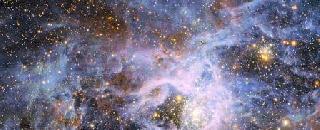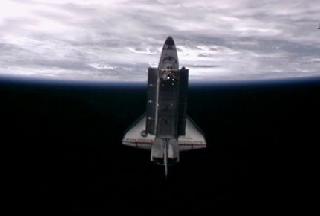
The brilliant star VFTS 682 in the Large Magellanic Cloud. An ESO photo
AMSTERDAM (BNS): An extraordinarily bright isolated star - three million times brighter than the Sun - has been found nearby a small neighbouring galaxy to the Milky Way.
But the origin of the star is a mystery - whether it form in isolation or was it ejected from a cluster- challenges astronomers’ understanding of star formation.
The star VFTS 682 was spotted earlier in a survey of the most brilliant stars in and around the Tarantula Nebula in the Large Magellanic Cloud, ESO said.
It lies in a stellar nursery - a huge region of gas, dust and young stars that is the most active star-forming region in the Local Group of galaxies.
An international team of astronomers by analysing the star’s light using the FLAMES instrument on the Very Large Telescope have discovered that it is about 150 times the mass of the Sun.
“We were very surprised to find such a massive star on its own, and not in a rich star cluster,” saids Joachim Bestenlehner, the lead author of the new study.
The study found that the star’s energy is being absorbed and scattered by dust clouds before it gets to Earth - it is actually more luminous than previously thought and among the brightest stars known.
Red and infrared light emitted by the star can get through the dust, but the shorter-wavelength blue and green light is scattered more and lost. As a result the star appears reddish.
As well as being very bright, VFTS 682 is also very hot, with a surface temperature of about 50 000 degrees Celsius, according to the study.
Although VFTS 682 seems to now be alone it is not very far away from the very rich star cluster RMC 136 (often called just R 136), which contains several similar “superstars.”
“The new results show that VFTS 682 is a near identical twin of one of the brightest superstars at the heart of the R 136 star cluster,” said Paco Najarro, another member of the team.
Is it possible that VFTS 682 formed there and was ejected? Such “runaway stars” are known, but all are much smaller than VFTS 682 and it would be interesting to see how such a heavy star could be thrown from the cluster by gravitational interactions, astronomers said.
 Previous Article
Previous Article Next Article
Next Article











The Indian Air Force, in its flight trials evaluation report submitted before the Defence Ministry l..
view articleAn insight into the Medium Multi-Role Combat Aircraft competition...
view articleSky enthusiasts can now spot the International Space Station (ISS) commanded by Indian-American astr..
view article